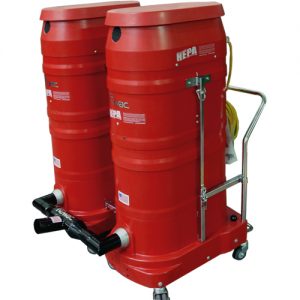HEPA VACS for CONCRETE & SILICA DUST
Crystalline silica is naturally found in soil, sand, granite, and many other minerals used within the concrete industry. Millions of U.S. workers in high risk jobs such as abrasive blasting, foundry work, stonecutting, rock drilling, quarry work and tunneling are exposed to dangerous levels of silica which can lead to serious health hazards in the form of cancer and respiratory issues, and OSHA’s changes to current regulations will decrease these risks.
Ruwac understands the importance of worker safety and job site cleanup, especially for those working with fine concrete dust and powders, as well as hazardous silica dust. All Ruwac vacuum cleaners filter 99% efficient at 0.5 microns with our standard equipment. Optional HEPA filtration listed below is available.
- Dust collectors feature CFMs recommended by the manufacturer for the specific equipment being operated
- Recommended vacuums meet 25 CFM / inch of blade per OSHA’s requirement for handheld grinders
- Stock MicroClean filter is compliant to OSHA’s silica dust standards at 99% efficient at 0.5 microns, preventing filter clogs and cutting down on costly filter replacements
- Equipped with a manual filter cleaning mechanism that easily keep the filters clean in between processes, foot-actuated dustpans or direct bagging collection systems allow for easy, dust-free emptying while reducing user exposure to contaminants
- Optional HEPA Maxx is MERV 18 at 99.997% at 0.3 microns and compliant to OSHA’s silica dust standards (Easily added to equipment in the field)
- Optional HEPA 2.0 is MERV 17 at 99.97% @ 0.3 microns and compliant to OSHA’s silica dust standards (Easily added to equipment in the field)
What Does OSHA’s Updated Rule Require?
- Workers’ exposures are limited to a new PEL of 50 micrograms of respirable crystalline silica per cubic meter of air (μg/m3) averaged over an 8-hour day. Action must be taken for any situation where the PEL is above 25 μg/m3.
- Provisions for measuring how much silica dust workers are exposed to, limiting workers’ access to areas where silica exposures are high, using effective methods for reducing exposures, providing medical exams to workers with high silica exposures, and training for workers about silica hazards and limiting exposure
Rule went into law on June 23, 2016. Must be in compliance by September 23, 2017.
Are You In Compliance With OSHA’s Silica Standards?
(via OSHA’s Small Entity Compliance Guide for the Respirable Crystalline Silica Standard for Construction)
1. Determine if the silica standard applies to your employees.
Could employees be exposed to respirable crystalline silica at or above 25 μg/m3 as an 8-hour TWA under any foreseeable conditions, including the failure of engineering controls, while performing construction activities?
No: No further action is required under the silica standard.
Yes: Choose to comply with the standard using either the:
- Specified exposure control methods in Table 1, or
- Alternative methods of compliance
2. Determine what additional requirements you must meet under the standard, based on the compliance
method you are following.
| Must the Employer Follow the Requirement? | ||
|---|---|---|
| Requirement | If Fully and Properly Implement Table 1 | If Following Alternative Exposure Controls |
| PEL | No | Yes |
| Exposure Assessment | No |
Yes, when exposures are reasonably expected to be above the action level.
|
| Methods of Compliance | No | Yes |
| Respiratory Protection | Yes, if respirator use is required by Table 1 | Yes, if respirator use is required to reduce exposures to the PEL |
| Housekeeping | Yes | Yes |
| Written Exposure Control Plan | Yes | Yes |
| Medical Surveillance |
Yes, for employees who must wear a respirator under the silica standard for 30 or more days a year.
|
Yes, for employees who must wear a respirator under the silica standard for 30 or more days a year.
|
| Communication of Hazards | Yes | Yes |
| Record Keeping |
Yes, for any employees who are getting medical examinations
|
Yes, for exposure assessments and for any employees who are getting medical examinations |
Table 1
This table lists several tasks and gives specific direction to reduce silica exposure, including engineering controls, practices and required safety equipment.

